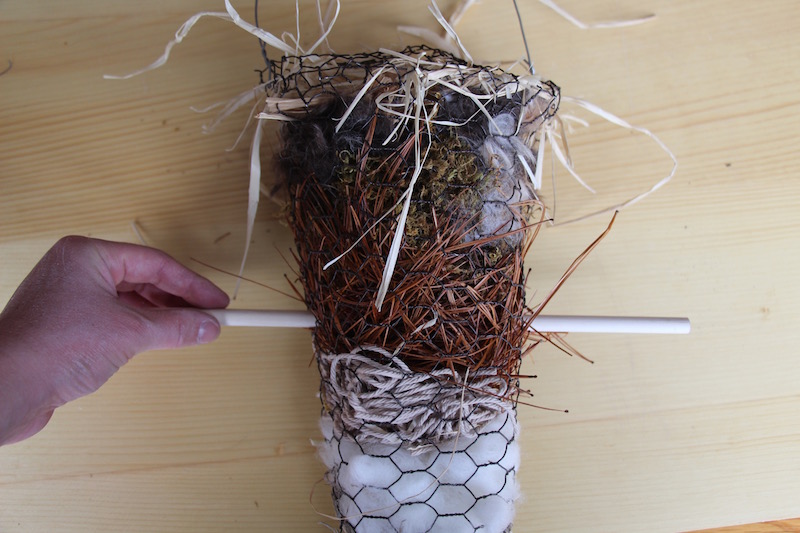
Bird nesting material can be provided in a holder that you can make yourself. It’s a great way to help wildlife build shelters.
A few years ago, soon after brushing one of our dogs in the backyard on an early spring day, we noticed lots of chickadees and wrens gathering the discarded hair in their beaks and flying off to use it in their nest-building efforts. It was such fun to see their little beaks stuffed to the brim with the soft, fluffy hair! Every spring since then, I build a new bird nesting material holder, fill it with natural materials, and hang it in the garden. The birds go crazy tugging the materials out of it and heading off to weave it into their nests. I often have to refill it multiple times throughout the spring and summer.
Here’s the fun and attractive way I build a holder for bird-nest building materials each spring. Now that a few years have passed since I started, I have six of these bird nesting material holders in our yard.
What You’ll Need to Construct a Bird Nesting Material Holder

- 1 piece of chicken wire, about 18-20 inches square, either the decorative type from a craft store or regular chicken wire from the farm supply store
- 2 wooden dowels, 12 inches long and .375 diameter
- 1 piece aluminum hobby wire, approximately 12-18 inches long
- 1 paddle of florist wire
- 1 tin snips or wire cutter
- a collection of the following natural bird-nest building materials: Spanish moss, reindeer moss, sheet moss, excelsior, jute twine pieces, cotton yarn or twine pieces, wool fibers, dog or cat hair, ornamental grass trimmings, white pine needles, coir fiber, cotton fiber or threads, dryer lint (do not include if you use a dryer sheet), natural raffia
Step-by-Step Directions
Step 1

To make a bird nesting materials holder, first lay the chicken wire out on a flat surface. Use the tin snips or wire cutter to cut it into a triangular shape. The long side should be about 18 to 20 inches wide; the short side should taper to a point. Save the pieces you cut off as you’ll use one of them in Step 5.
Step 2

Roll the triangular piece of chicken wire into a funnel shape and use a few pieces of florist wire from the spool to fasten the ends together along the seam. Close off the small end of the funnel by bending it closed or using another piece of wire to fasten it shut.
Step 3

Use the piece of aluminum hobby wire to make a hanger for your bird-nest building materials holder by attaching one end to one side of the top opening of the chicken wire funnel and the other end on the opposite side of the opening. Make sure the funnel hangs straight before filling it.
Step 4

Fill the funnel with the bird nesting materials. You can do it in separate layers of materials or mix all the materials together. If you have trouble getting the material all the way into the bottom of the funnel, use one of the dowels to push it down to the point.
Step 5

Cut a square or circle of chicken wire from leftover wire from Step 1. It should be slightly larger than the top opening of the funnel. Position it over the opening of the funnel to make a lid and wire it into place using the florist wire or simply by bending the cut wire ends of the lid over the top edge of the funnel.
Step 6

Push the two wooden dowels through one of the openings in the chicken wire about 6 to 8 inches from the top of the funnel until it comes out the opposite side. Make sure the dowel is level and then wire it into place on each side with small pieces of florist wire. Put the other dowel about 6 to 8 inches below the top one, again wiring it into place after making sure it’s level. Some birds will cling to the wire to pull the bird nesting materials from the funnel, but these dowels serve as perches for the species of birds who aren’t able to grab onto the wire.
Bird Nesting Material Holder: Finished Project

Hang your holder of bird nesting materials out in the yard or garden, close to a bird feeder or nesting box, if possible. I hang mine in late February or early March here in Pennsylvania, as that’s typically when the birds begin to build their nests. I refill it as necessary and leave it in place until late summer since some birds have multiple broods per season and may need to build new nests.
If you enjoy seeing lots of birds in your garden, here are a few other DIY projects for the birds:
This article about making a DIY bird nesting material holder was written for Hobby Farms magazine. Click here to subscribe.




